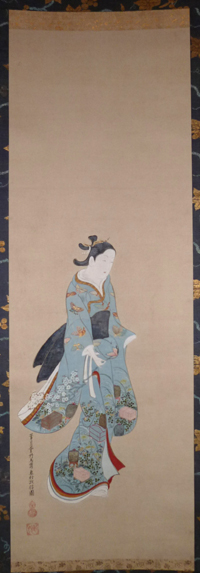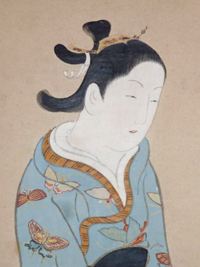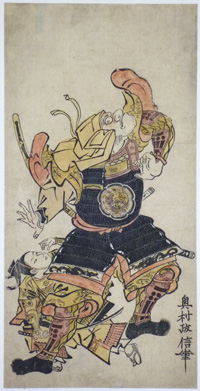Okumura MASANOBU (1686-1764)

Click here to view image full size.
One of the most influential and innovative print designers, publishers and painters. He is also credited with inventing the hashira-e as well as being the first to use multiple-block printing. A wide hashira-e (habahiro hashira-e, 24 x 6 in; 61 x 15 cms) showing the actor Sanogawa Ichimatsu I. Masanobu designed a number of prints showing this popular actor who started the fashion for the hisobi pattern on his costume which is now called the Ichimatsu moyo. Published by Masanobu c 1741. Rare.
Fine impression. Hand-applied colour: yellow, light red and light orange. Slight fading, otherwise very good condition. Signed Hogetsudo shomei Okumura Bunkaku Masanobu shohitsu, “Truly published by Hogetsudo and true brush by Okumura Masanobu” with seal Tanchosai.
Status: Available
Okumura MASANOBU (1686 -1764)

Click here to view image full size.
An hosoban showing banners for the Boy’s Festival held on the fifth day of the fifth month. These depicted Shoki, the Demon Quellor. One Shoki has come alive and leaps down from the banner to attack an oni – his traditional foe. At the top left on a small banner is the title: Nobori no Shoki, “Shoki the Devil-Quellor.” Masanobu was one of the most influential artists in Ukiyo-e. His long life covered hand-coloured prints through to full colour printing in the mid 1760s and he was one of the first to use the block-printing process after 1740 and pioneer the benizuri-e picture. Extremely innovative: he pioneered the uki-e print, pillar print and ishizuri-e. Not only was he a print artist, he also illustrated books, albums and produced paintings. He started his own publishing house, Okumuraya, which gave him greater control over the printing process. The popularity of his work led to many copies by other publishers, and he had to certify his work as being the “genuine” article. Published c 1725 by Tori-shio-cho, kongen Okumura hammoto. Kono ho no e nise han soro aida hyotan shirushi idashi soro. Provenance: Ex Schindler collection with seal au verso. See Masterpieces Of Ukiyoe-e Prints from The Schindler Collection, Nihon Keizai Shimbun Inc., 1985, no. 8, page 22. Extremely rare.
Very good impression and colour. Urushi: hand coloured with yellow, tan, green and sumi wash. Small edge repair top left, otherwise very good condition. Signed Nihon gwako Masanobu sho-hitsu with Okumura seal.
Status: Sold
Okumura MASANOBU (1686-1764)

Click here to view image full size.
An hashira-e showing Shoki, the Chinese demon queller, Chung Kwei, about to plunge a sword into an oni. Another pillar print showing Shoki from the same period is illustrated in The Clarence Buckingham Collection of Japanese Prints, The Primitives, Helen C. Gunsaulus, AIC, 1955, no. 103, p. 166. Published c. 1745. Rare.
Very good impression. A sumi-e, printed in sumi with washes of sumi applied by hand. Slight toning, otherwise very good condition.Pillar prints are often toned because they were hung and, of course, this is especially true of the earlier examples, as here. Signed Hogetsudo
Tanchosai Okumura Bunkaku Masanobu Baio ga with seal Tanchosai.
Status: Sold
Okumura MASANOBU (1686-1764)

Click here to view image full size.
The Fourth Month, Shibumukute toshimano mumami jukushi kaki, “Well Aged and Ripe Persimmon” from a set of 12 shunga prints Someiro no yama, Neya no hinagata, “Mountains of Dyed Colours, Patterns for the Bedroom.” One of the finest shunga sets; of large size and beautifully hand coloured. Published c. 1740. Others from the set are illustrated in Tim Clark, Shunga: Sex and Pleasure in Japanese Art, BM, 2013, p. 147-151. Masanobu is one of the most important figures in Ukiyo-e being the proprietor of a shop but also a publisher, an illustrator of books, print publisher, painter, and inventor of the hashira-e and uki-e as well as being at the forefront of advancements in colour printing. Rare.
Very good impression, colour and condition.
Status: Sold
Okumura MASANOBU (1686-1764)

Click here to view image full size.
The fifth month from a set of twelve prints Someiro no yama: Neya no hinagata, “Mountains of Dyed Colours: Patterns for the Bedroom.” A haiku poem relating to the time of year on each design. Published c. 1740. Shows a couple in flagrante in a room with sliding doors painted with images of Mount Fuji and the poet Ariwara no Narihira admiring the mountain. One of the great Shunga sets with fine contemporary hand-colouring: The careful colouring on impressions from this set was obviously carried out by skilled artisans and is exceptional with the sumi screens being almost painterly: Colouring is often later on early shunga prints, and even if contemporary can be slipshod. Masanobu was a great innovator, developing new formats and technical advances. Unidentified collector’s seal bottom left. Rare.
Very good impression. Slight weakening along laid lines, otherwise very good condition.
Status: Sold
Okumura MASANOBU (1686-1764)

Click here to view image full size.
A design from a set of twelve prints Someiro no yama: Neya no hinagata, “Mountains of Dyed Colours: Patterns for the Bedroom.” A haiku poem relating to the time of year on each design. Published c 1740. Shows a couple in flagrante in a room with a free-standing screen and a view outside of an engawa and garden with a stone water cistern. One of the great Shunga sets with fine contemporary hand-colouring: The careful colouring on impressions from this set was obviously carried out by skilled artisans and is exceptional with the sumi screen being almost painterly: Colouring is often later on early shunga prints, and even if contemporary can be slipshod. Masanobu was a great innovator, developing new formats and technical advances. Unidentified collector’s seal bottom right. A beautiful design. Rare.
Very good impression and condition.
Status: Sold
Okumura MASANOBU (1686-1764)

Click here to view image full size.
Shogatsu, “First Month” from a shunga set Someiro no yama neya no hinagata, “Mountains of Dyed Colours, Examples for the Bedroom.” Shows a New Year scene with the master of an opulent household enjoying the holiday with his wife and a young man of his fancy. The poem alludes to the pleasures of both male-male and male-female sex. Published c 1740. Others from the set are illustrated in Tim Clark, Shunga:Sex and Pleasure in Japanese Art, BM, 2013, pp. 147-151. Masanobu is one of the most important figures in Ukiyo-e being the proprietor of a shop but also a publisher, an illustrator of books, print publisher, painter, and inventor of the hashira-e and uki-e as well as being at the forefront of advancements in colour printing. Rare.
Fine impression. Hand colouring, slightly faded. Minor backed wormage, but otherwise very good condition given the date.
Status: Sold
Okumura MASANOBU (1686-1764)
Click here to view image full size.
A newly discovered painting by one of the most influential artist in Ukiyo-e. His long life covered hand-coloured prints through to full colour printing in the mid 1760s and he was one of the first to use the block-printing process after 1740 and pioneer the benizuri-e picture. Extremely innovative: he pioneered the uki-e print, pillar prints and ishizuri-e. Not only was he a print artist, he also illustrated books, albums and produced paintings. He started his own publishing house, Okumuraya, which gave him greater control over the printing process. The popularity of his work led to many copies by other publishers, and he had to certify his work as “genuine.” Shows a standing beauty, Tachi bijin-zu. She carries a cherry branch and her gorgeous costume is decorated with grasses and flowers with cages for collecting insects and above various colourful butterflies. Full colour on paper, image size 35.75 x 12.25 in; 91 x 31 cms. Fine new mount with futo-maki ( thick wooden roll to preserve the painting from damage ) and box. Fine condition. Ex collection Raizou Kanda. Signed Hogetsudo Tanchosai Okumura Masanobu with seals Masanobu and Okumura. Although long lived, genuine paintings by him are rare.
Status: Sold
Okumura MASANOBU (1686-1764)

Click here to view image full size.
A large benizuri-e oban (16.75 x 12 in) showing a pair of lovers in the guise of komuso (medicant monks). They walk in high geta and have a black monk’s stole draped around their shoulders. They are playing the classic komuso tune renbo nagashi on their shakuhachi. He wears the deep sedge tengai hat. A hokku verse is on the right. Provenance: Ex collection Henri Vever, sealed bottom right. Sold Sothebys, Highly Important Japanese Prints from the Henri Vever Collection: Final Part, 30/9/1997, lot 6. Extremely rare: Probably the only recorded impression.
Very good impression and colour. Wormhole expertly repaired at right edge, otherwise very good condition. Signed Hogetsudo Tanchosai Okumura Bunkaku Masanobu shohitsu with two seals Tanchosai and Okumura Masanobu.
Status: Sold
Okumura MASANOBU (1686 – 1764)
Click here to view image full size.
A hosoban showing the fight between Ushiwaka Maru ( Yoshitsune ) and Benkei on Gojo Bridge ( 1170 ). Arguably the most influential figure in ukiyoe, reputedly being the innovator of colour printing. An urushi-e, coloured by hand in yellow, tan, lilac, gofun and heavy sumi over embossed lines. Published c 1725. Ex collections Tony Straus-Negbaur and Walter von Scheven ( 1878 – 1950 ) and purchased by him at Cassirer & Helbing, 1928, lot 64, ( from Tony Straus-Negbaur ). Extremely rare.
Very good impression. Slight soil and small repaired edge wormholes. But generally very nice condition for such an example. Signed Okumura Masanobu hitsu.
Status: Sold
Okumura MASANOBU (c.1686-1764)
Click here to view image full size.
A major artist attributed with the invention of the hashira-e and uki-e and who may have been the first to change from hand colouring to colour printing. Tera no kashi, “Sweets From a Temple” from Masanobu’s most highly regarded shunga set: Someiro no yama neya no hinagata, “Mountains of Dyed Colours, Examples of Bedrooms.” Published c. 1735. Sub-title: Sato Kosho sai, Kichisaburo. Shows a young monk copulating with a beauty in the vicinity of a temple. Hence the punning title. Four other illustrations from this set illustrated in Shunga, Tom and Mary Evans, 1975, 5.64 – 5.67. Extremely rare.
Very good impression. Careful contemporary hand colouring ( as all prints for this series ). The red pigment with gum added. Centre fold ( as per usual ) with repair at top edge. Slight soil, otherwise very good condition for this period. Unsigned.
Status: Sold
Okumura MASANOBU (1686-1764)
Click here to view image full size.
A pair of lovers. Obviously one sheet from a shunga album. A sumizuri-e print with careful hand-colouring. Although possibly not contemporary the colouring certainly has considerable age. Published c 1710s.
Very good impression. Slight offsetting of sumi and other minor soil and backed wormholes. Centre fold.
Status: Sold
Okumura MASANOBU (1686-1764)
Click here to view image full size.
A pair of lovers. Obviously one sheet from a shunga album. A sumizuri-e print with careful hand-colouring. Although possibly not contemporary the colouring certainly has considerable age. Published c 1710s.
Very good impression. Slight offsetting of sumi and other minor soil and backed wormholes. Centre fold.
Status: Sold








